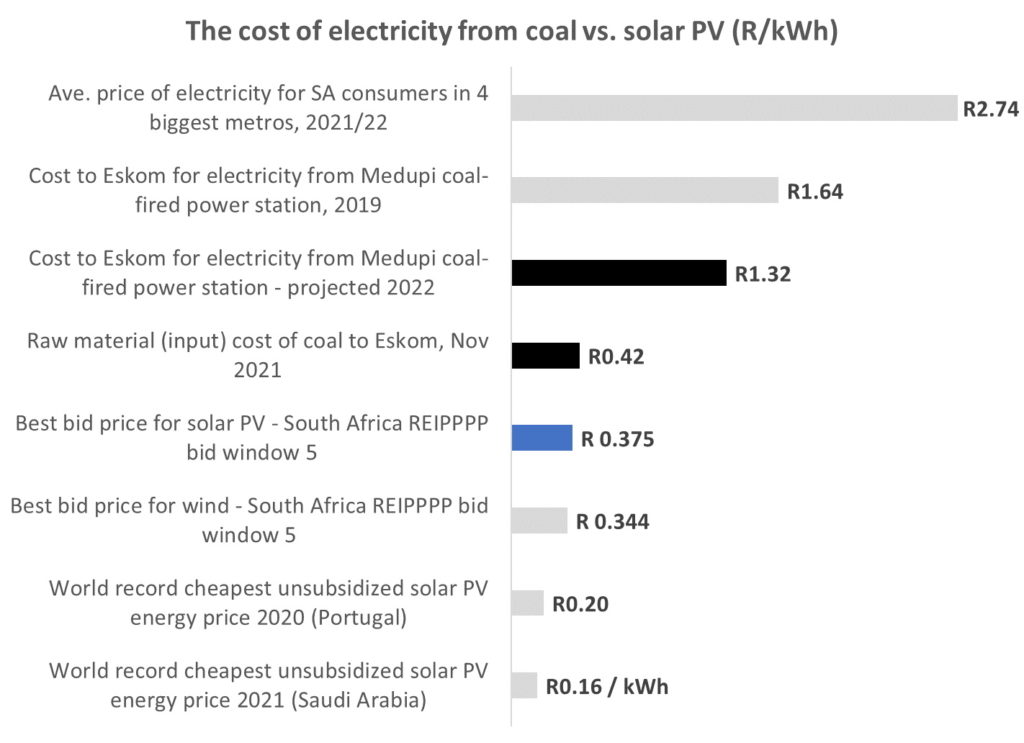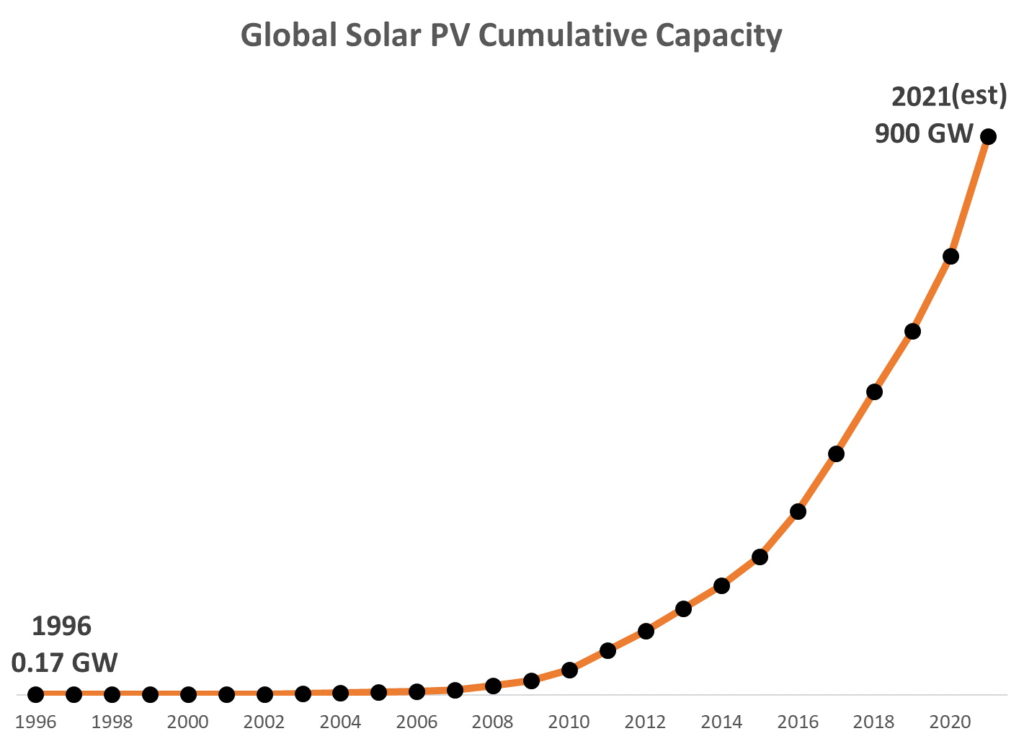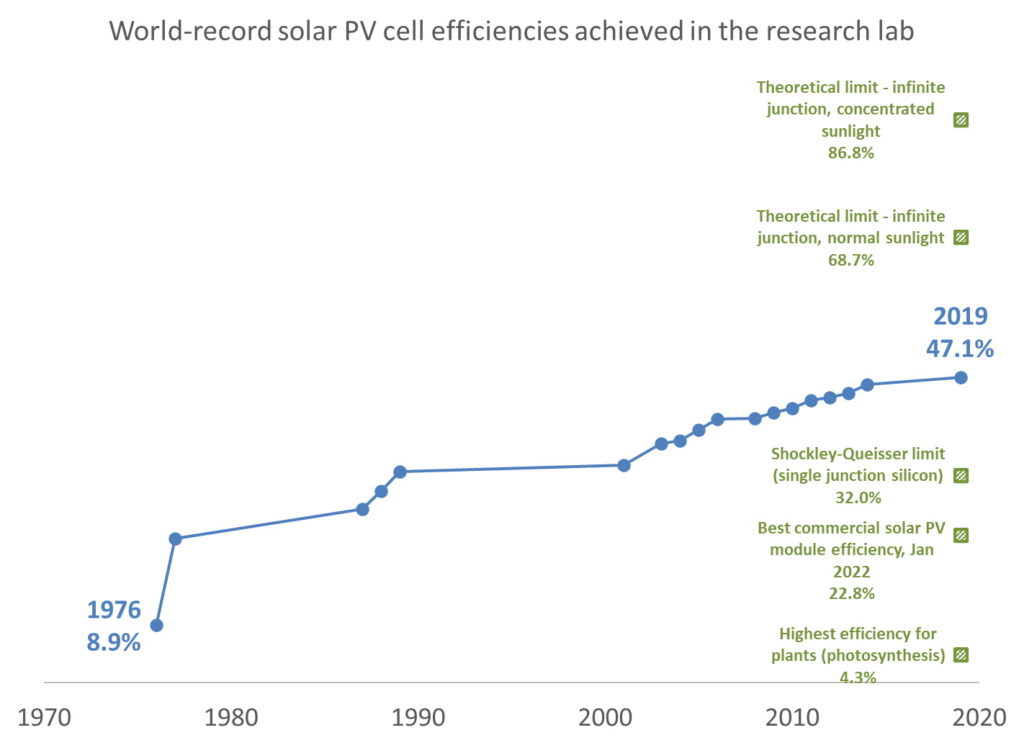Solar photovoltaic (PV) technology has advanced at an astonishing pace over the past 15 years, even against a 21st Century background of rapid technological progress.
This is catalysing the democratisation of energy – making household-scale energy generation affordable and universally accessible. It also hints at the tantalizing concept of superabundant energy (more on this later).
Energy is the cornerstone of civilization, quality of life and progress. The potential impact of ubiquitous affordable energy is hard to overstate!
Let’s look at some key numbers on the breath-taking progress in solar PV cost and technology.
The price of solar PV modules has reduced by 99.6% in real terms from 1976 to 2021, from $106.10/W (about R1600/W) to $0.33/W (about R5.10/W) [1, 2]. In January 2022, spot prices for polycrystalline solar PV modules on the international market were at $0.21/W (about R3.26/W) [3].

The world record for the cheapest unsubsidized solar PV energy (at utility scale) in 2020 was for a project in Portugal at 1.316 US cents/kWh or about R0.20/kWh [4]! This is the price at which a private consortium is selling electricity to the Portuguese grid at a profit.
The fact that Portugal has lower solar irradiation than South Africa makes it all the more impressive.
In 2021, a new world record was again set for the cheapest unsubsidized solar PV energy, this time for a project in Saudi Arabia, where a bid for a 600 MW project was awarded at 1.04 US cents/kWh or about R0.16/kWh [5].
In comparison, South African consumers in the 4 biggest metropolitan municipalities paid over R2.70/kWh on average for electricity in 2021/22 (see our article here).
The cost to Eskom for electricity from its new Medupi coal-fired power station in 2019 was R1.64/kWh, with the hope that it would decrease to R1.32/kWh by 2022 [6].
In fact, just the raw material cost of coal in South Africa for producing 1 kWh of electricity, was an average of R0.42/kWh as of November 2021 [7]. This is before adding operating expenses and capital cost of a coal-fired power plant.
Compare this to the best bid prices in SA’s REIPPPP (Renewable Energy Independent Power Producer Procurement Programme) bid window 5 in 2021, which were R0.375/kWh for solar PV and R0.344/kWh for wind [8].
Thus, the cost of electricity from solar PV and wind in South Africa (to Eskom) is already about 4 times lower than the cost of electricity from Eskom’s most modern coal-fired power station (Medupi) and is already lower than the raw material (input) cost of coal.

With such a dramatic reduction in price, it is no surprise that the global installed solar PV capacity has been growing exponentially, reaching an estimated 900 GW by 2021 [9, 10]. For perspective, this is about 15 times South Africa’s total installed capacity of 58 GW [11, 12].

It is well known that there is a virtuous cycle where increased adoption leads to improvements in manufacturing and economies of scale, which leads to reduced pricing, which leads to increased adoption. This is called the learning rate – for solar PV it is about 20%. This means that, for every doubling in global solar PV production capacity, the price decreases by about 20% [13].
The good news doesn’t stop there. At the same time that prices have been decreasing, efficiency has been steadily increasing. (Efficiency for solar PV refers to the percentage of energy contained in the sun’s rays that is converted into electricity.)
Better efficiency means a smaller roof space is required for the same power output (or you can get more energy from the same roof space).
Higher efficiency PV modules also save in installation materials and labour cost (due to fewer modules needed).
The theoretical efficiency limit for solar cells made of silicon (which is the current main base material used for solar PV modules) and which has a single junction is about 32%. This is called the Shockley–Queisser limit [14, 15]. However, by using multi-junction cells or other emerging technologies, this limit can be overcome. The theoretical limit for an infinite junction cell in normal sunlight is 68.7% and in concentrated sunlight 86.8% [15].
The current world record solar PV research cell efficiency (in other words, efficiency achieved for a single solar PV cell in the lab) is 47.1%, set in 2019 [16].
Compare that to the best photosynthetic efficiency achieved by plants, which is about 4.3% [17]. This means we have already managed to improve on the best of more than 3 billion years of organic evolution by a factor of 10!
Commercially available solar PV modules tend to be quite far behind the best lab efficiencies, due to manufacturing cost. The best commercially available solar PV module efficiency at the start of 2022 was about 22.8% [18].

It’s not just solar PV that has seen dramatic progress in the past decade or two. Storage, especially lithium-ion battery storage, has also been improving at a rapid pace. The price of lithium-ion batteries has fallen by 97% over the past 30 years, with prices falling at an average of 19% for every doubling of capacity (the learning rate) [19].
There is a concept called ‘grid parity’, where the cost of renewables becomes cheaper than the cost of electricity from the grid. Whilst this has already been achieved for solar PV in most countries, the problem is the intermittency of solar PV.
This brings us to the related concept of ‘solar-plus-storage grid parity’. This is where the combined cost of solar PV plus (typically lithium-ion battery) storage becomes cheaper than the cost of electricity from the grid. At this point it makes financial sense to go completely off-grid for a household or business’ electricity requirements.
Grid parity for solar-plus-storage has already been reached in some European countries [20], and is projected to be reached for most countries before 2030, including countries like South Africa and India [21, 22, 23].
In fact, according to an analysis by Nedbank, already since 2021 a financed solar-plus-storage system of R150 000 in South Africa would yield a net monthly savings (in other words, the reduction in electricity bill is larger than the instalment on the loan to finance the solar-plus-storage system) [24].
This analysis was not for a fully off-grid system, but it confirms that grid parity is fast approaching.
With a plethora of promising battery technologies under development (see for example here, here and here), the momentum seems unstoppable.
Are we nearing the plateauing of improvements in solar PV technology? It seems not – in recent years, once-exotic technologies such as half-cells and PERC (passivated emitter and rear contact) have become mainstream.
With a long list of promising technologies appearing on the horizon, the future looks rosy. Perovskite and multi-junction cells could potentially take us past the Shockley-Queisser limit for commercial modules, as can quantum dots, which entails adding a quantum dot-containing film to a standard silicon solar PV module to boost efficiency to about 35%. Since adding such a film is an easy addition to the manufacturing process, it should be scalable and cost-efficient.
Then there is the fascinating concept of Super Power coined by RethinkX – the idea that it would make financial sense to install 3 – 5 times more solar PV generation capacity than is required at peak time. This would make for the lowest overall grid cost due to much less battery storage being necessary, and would make for a huge surplus of near-zero marginal cost energy, which would create new growth opportunities and new ways of doing things. Imagine what you would do with ‘almost free’ energy?
As RethinkX put it so succinctly:
“We are on the cusp of the fastest, deepest, most profound disruption of the energy sector in over a century.”
Photo of solar PV array by Nuno Marques on Unsplash
[1] Our World in Data. Solar PV module prices. Website: https://ourworldindata.org/grapher/solar-pv-prices. Last accessed: 2022/01/31.
[2] Gifford J. 2022. Higher PV module prices may point to stable demand and more sustainable pricing trends. Website: https://www.pv-magazine.com/2022/01/04/higher-pv-module-prices-may-point-to-stable-demand-and-more-sustainable-pricing-trends/. Last accessed: 2022/01/31.
[3] PVInsights. Website: http://pvinsights.com/. Last accessed: 2022/01/31.
[4] Tsagas I. 2021. The weekend read: The recent evolution of solar PV energy costs. Website: https://www.pv-magazine.com/2021/01/23/the-weekend-read-the-recent-evolution-of-solar-pv-energy-costs/. Last accessed: 2022/01/31.
[5] Saudi Arabia achieves two new world record solar tariffs. Website: https://energy-utilities.com/saudi-arabia-achieves-two-new-world-record-solar-news111675.html. Last accessed: 2022/01/31.
[6] Mallinson C. 2020. Coal or renewables? The answer is in the numbers. Website: https://www.dailymaverick.co.za/article/2020-09-03-coal-or-renewables-the-answer-is-in-the-numbers/. Last accessed: 2022/01/31.
[7] Cohen T. 2021. Renewable energy: “Reipppping’ the whirlwind of green power projects in South Africa. Website: https://www.dailymaverick.co.za/opinionista/2021-11-14-renewable-energy-reipppping-the-whirlwind-of-green-power-projects-in-south-africa/. Last accessed: 2022/01/31.
[8] Planting S. 2021. Best plan to keep the lights on: Solar and wind power officially cheaper than coal. Website: https://www.dailymaverick.co.za/article/2021-11-04-best-plan-to-keep-the-lights-on-solar-and-wind-power-officially-cheaper-than-coal/. Last accessed: 2022/01/31.
[9] Our World in Data. Solar PV Cumulative Capacity. Website: https://ourworldindata.org/grapher/solar-pv-cumulative-capacity. Last accessed: 2022/02/01.
[10] Rai-Roche S. 2021. Global solar installations to hit 191GW in 2021 – BNEF. Website: https://ieefa.org/global-solar-installations-to-hit-191gw-in-2021-bnef/. Last accessed: 2022/02/01.
[11] USAid. South Africa Power Africa Fact Sheet. Website: https://www.usaid.gov/powerafrica/south-africa. Last accessed: 2022/02/01.
[12] Booysen MJ & Rix A. 2021. South Africa’s power grid is under pressure: the how and the why. Website: https://theconversation.com/south-africas-power-grid-is-under-pressure-the-how-and-the-why-170897. Last accessed: 2022/02/01.
[13] Roser M. 2020. Why did renewables become so cheap so fast? Website: https://ourworldindata.org/cheap-renewables-growth. Last accessed: 2022/02/01.
[14] The Shockley-Queisser limit. Website: https://ph.qmul.ac.uk/sites/default/files/u75/Solar%20cells_environmental%20impact.pdf. Last accessed: 2022/02/02.
[15] Wikipedia. Shockley-Queisser limit. Website: https://en.wikipedia.org/wiki/Shockley%E2%80%93Queisser_limit. Last accessed: 2022/02/02.
[16] NREL. Best Research-Cell Efficiency Chart. Website: https://www.nrel.gov/pv/cell-efficiency.html. Last accessed: 2022/02/02.
[17] Wikipedia. Photosynthetic efficiency. Website: https://en.wikipedia.org/wiki/Photosynthetic_efficiency. Last accessed: 2022/02/02.
[18] Lane C. 2022. Solar panel efficiency: how much it matters, top brands & more. Website: https://www.solarreviews.com/blog/what-are-the-most-efficient-solar-panels. Last accessed: 2022/02/02.
[19] Ritchie H. 2021. The price of batteries has declined by 97% in the past 3 decades. Website: https://ourworldindata.org/battery-price-decline. Last accessed: 2022/02/02.
[20] Martin JR. 2019. Solar-plus-storage grid parity sweeps through top EU markets. Website: https://www.pv-tech.org/solar-plus-storage-grid-parity-sweeps-through-top-eu-markets/. Last accessed: 2022/02/02.
[21] Niclas. Grid Parity: definition of the holy grail in solar energy. Website: https://sinovoltaics.com/learning-center/basics/grid-parity/. Last accessed: 2022/02/02.
[22] Pandarum A. “Price Parity” of Solar PV with Storage? Website: https://www.ameu.co.za/Price_Parity_of_Solar_PV_with_Storage_-_A_Pandarum.pdf. Last accessed: 2022/02/02.
[23] Gupta U. 2021. Financial feasibility of behind-the-meter solar-plus-storage in India. Website: https://www.pv-magazine-india.com/2021/07/29/financial-feasibility-of-behind-the-meter-solar-plus-storage-in-india/. Last accessed: 2022/02/02.
[24] Ching’andu B. 2021. Business Case for Residential PV. SAPVIA Webinar 29 July 2021.
Questions? We’ll get back to you on how to join our journey!
I want updates from Elon Smart Water (you can unsubscribe at any time)
By clicking submit, you consent to PowerOptimal storing and processing personal information.
Please read our Privacy Policy.
PowerOptimal and Elon Smart Water are committed to protecting and respecting your privacy.